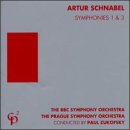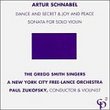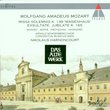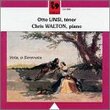| All Artists: Artur Schnabel, Jacqueline Hartley, Paul Zukofsky, BBC Symphony Orchestra, Prague Symphony Orchestra Title: Schnabel: Symphony No.1/Symphony No.3 Members Wishing: 2 Total Copies: 0 Label: Cp2 Records Release Date: 4/16/1996 Genre: Classical Styles: Historical Periods, Modern, 20th, & 21st Century, Symphonies Number of Discs: 1 SwapaCD Credits: 1 UPC: 096661010922 |
Search - Artur Schnabel, Jacqueline Hartley, Paul Zukofsky :: Schnabel: Symphony No.1/Symphony No.3
 | Artur Schnabel, Jacqueline Hartley, Paul Zukofsky Schnabel: Symphony No.1/Symphony No.3 Genre: Classical
A massive work, Symphony No. 1 is scored for three flutes (the second and third doubling piccolo), three oboes, three clarinets, three bassoons (the third doubling contrabassoon), four horns, three trumpets, three trombone... more » |
Larger Image |
CD Details
Synopsis
Album Description
A massive work, Symphony No. 1 is scored for three flutes (the second and third doubling piccolo), three oboes, three clarinets, three bassoons (the third doubling contrabassoon), four horns, three trumpets, three trombones, five percussion, and strings. Structurally, the Symphony follows the four-movement-model previously laid out in the 1935 Violin and Piano Sonata, and both this Symphony and the Sonata helped shape the 1941-3 Symphony No. 2--in some instances, quite specifically (i.e. compare the openings of the third movements of Symphonies 1 and 2). Pitchwise, Symphony No. 1 uses various collections of six or seven pitches each, with the Dorian mode being one of the collections. These pitch collections spread over various interval ranges (major seventh, minor sixth or tritone, i.e. the elegiac trumpet solo of the third movement, played by William Hougton, is based within two ranges, each range spanning a tritone), and the collections are freely manipulated melodically, contrapuntally, and harmonically. Within these pitch collections, and especially within the opening motive, the intervals of a minor second and that of a perfect fifth play pivotal (indeed almost motival) roles. Symphony No. 1 is by far the densest of the Symphonies. In contrast, Symphony No. 3 is far more concise, far less declamatory, emphasizing free counterpoint over harmony, and in general having a phrasing and syntax far more segmented, almost bordering on the abrupt. If ever Schnabel was at his most prescient, and at the cusp of what was "in the air" (see my notes to Symphony No. 2) it is in the work that Symphony No. 1 is paired with on this CD. According to various letters, Symphony No. 3 (scored for winds by threes, four horns, four trumpets, three trombones, tuba, percussion, piano and strings) was written in the summer of 1948 (although the finished score bears dates between June 25 and September 11, 1949, with the designation Los Gatos). On July 7 (1948) Schnabel wrote (from Sils Maria) that he had started a "3rd Symphony"; and on July 19: "I have finished the first movement of the new symphony and written 2/3 of the second"; ...somewhat later: "I am on the last movement. It presents a special problem. Using an old tune of mine as its basis, I discovered the attractive, but often seemingly insoluble difficulty of combining the free use of musical material, which is the great advantage of so-called atonality, with the limited use of it, which to me, in the development of musical ideas, has become absolutely shop-worn, and which no trick of spicing can save from shallowness." The "old tune of mine" is the theme (played by Joseph Ruzicka (with thanks to JN for one D#)) of the last (i.e. second) movement of Schnabel's 1899 Piano Concerto (although the notation has been changed from a more propulsive 2/4 of the Piano Concerto to the 4/4 of the Symphony).
Similar CDs
| Mozart, Harnoncourt, Bonney Missa Solemnis Genres: Pop, Classical Label: Elektra / Wea | |

 Track Listings (8) - Disc #1
Track Listings (8) - Disc #1

